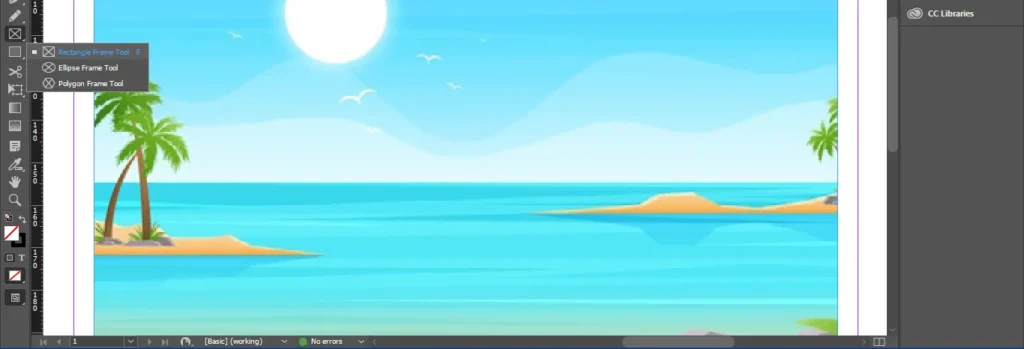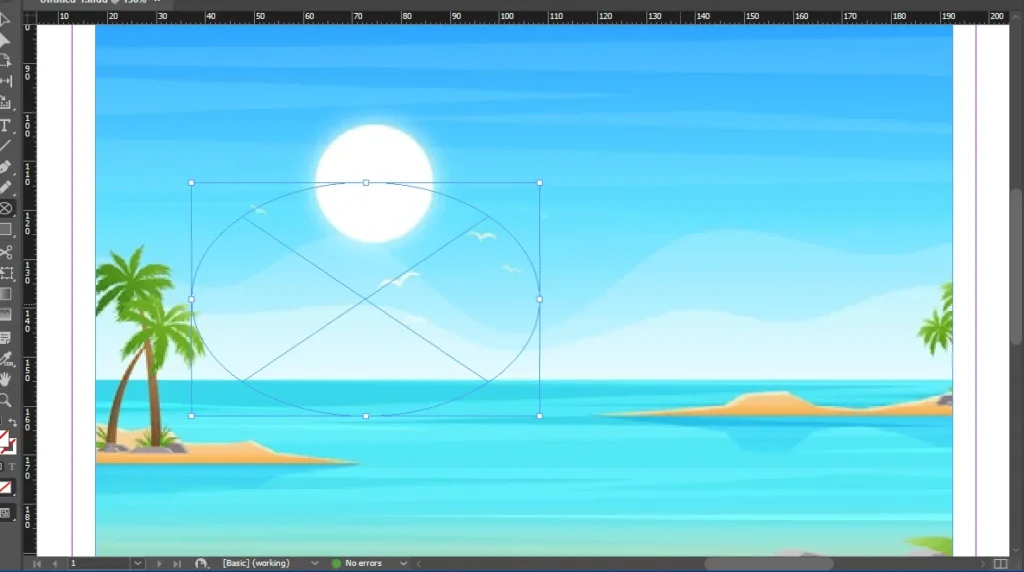A clipping mask is a fundamental image editing method for selective adjustments. The photo editors must know the process of creating a clipping mask. This is the best way to get professionally edited photos. That’s why getting an in-depth understanding of the on-clipping mask is essential.
If you are the best way to make a clipping mask in InDesign, you are at the right place. Here, you will learn the step-by-step procedure to create a mask effect. So, without further ado, let’s start.
What is a Clipping Mask?
A clipping mask is a feature in graphic design software, including Adobe InDesign, that allows you to control the visibility of an object or image based on the shape of another object. It enables you to create engaging and complex compositions by masking out portions of an image or graphic, revealing only the areas that fit within a defined shape.
Clipping masks are commonly used to crop images, create custom shapes, apply special effects, or combine multiple elements into a cohesive composition. They provide a non-destructive way to control the visibility and presentation of content, allowing you to experiment and make changes without permanently altering the original objects or images.
Using clipping masks in InDesign, you can achieve various creative effects, such as placing an image within the text, revealing specific parts of an image through a shape, or seamlessly blending multiple images. It gives you flexibility and control over your designs’ display and presentation.
What is InDesign?
Adobe InDesign is a professional desktop publishing software developed by Adobe Systems. It is widely used in the design industry for creating print and digital media, such as magazines, newspapers, brochures, posters, eBooks, interactive PDFs, and more. InDesign provides robust tools and features specifically designed for layout design, typesetting, and graphic design.
Steps For Creating a Clipping Mask in InDesign
In InDesign, most objects are contained within frames. Interestingly, these frames are inherent clipping masks. Since the structure and its content can be moved independently, InDesign includes this basic masking functionality as a core feature.
To create a clipping mask in InDesign, you can start by designing a vector shape and inserting your desired image into that shape. By utilizing a vector shape in InDesign, you can designate it as the clipping mask for your image, replacing the default rectangle. This straightforward process remains consistent for any vector shape you choose within InDesign.
A. Clipping Masks Using the Frame Tool
Step 1 – Launch Adobe InDesign
Launch Adobe InDesign and open your document or create a new one. Place the image or graphic you want to use into your document by going to “File” > “Place” and selecting the file from your computer.
Step 2 – Transform Tool

You can select the central circle on the image and move it accordingly to reposition the images within the frame. The Transform Tool can also trim or clip the image edges if necessary.
Step 3 – Frame Shape Tool

Select the Rectangle Frame Tool (or any other frame shape tool you prefer) from the Tools panel on the left. Select the Ellipse Frame Tool from the toolbar in InDesign.
Step 4 – Create A Frame Shape

Click and drag on your document to create a frame shape. This shape will define the visible area of the image.
Step 5 – Clip Within the Frame

With the frame selected, go to “File” > “Place” and choose the image you want to clip within the frame.
Step 6 – Adjust The Image Placement and Size
Position and resize the image within the frame as desired. You can use the Selection Tool (black arrow) to adjust the image placement and size.

Step 7 – Layer Order
Make sure the image is positioned below the frame in the layer order. To do this, go to “Object” > “Arrange” > “Send to Back.”
Step 8 – Clipping Mask in InDesign
With both the image and frame selected, go to the “Object” menu and choose “Clipping Path” > “Make.” Alternatively, you can use the keyboard shortcut Ctrl+7 (Windows) or Command+7 (Mac) to create the clipping mask.

Step 9 – Adjust or Reposition the Frame Shape
The frame shape now acts as a mask, clipping the image within its boundaries. You can adjust or reposition the frame shape, and the image will update accordingly within the clipping area.
B. Clipping Mask Using Customized Frame Shapes in InDesign
To create an InDesign clipping mask vector using customized frame shapes in InDesign, you can follow these steps:
Step 1 – Open Adobe InDesign
Open Adobe InDesign and open your document or create a new one.
Step 2 – Select The Pen Tool
Select the Pen Tool or any other shape tool you prefer from the Tools panel on the left.
Step 3 – Draw The Customized Shape

Draw the customized shape on your document by clicking and dragging to create anchor points and shape segments. Customize the shape to your desired form.
Step 4 – Selection Tool
Select the Selection Tool (black arrow) from the Tools panel once the shape is created.
Step 5 – Created A Shape
To proceed, we need to place the image inside our newly created shape to use it as a clipping mask. With the Selection Tool active, click on the image to select it. Then, remove it by cutting it (Edit > Cut).
Place the image you want to clip within the customized shape by going to “File” > “Place” and selecting the image file from your computer.
Step 6 – Use The Selection Tool
Position and resize the image within the customized shape as desired. Use the Selection Tool to adjust the image’s placement and size.
Step 7 – Customized Shape in the Layer Order
Ensure the image is positioned below the customized shape in the layer order. To do this, go to “Object” > “Arrange” > “Send to Back.”
Step 8 – Clipping Path
With both the image and the customized shape selected, go to the “Object” menu and choose “Clipping Path” > “Make.” Alternatively, you can use the keyboard shortcut Ctrl+7 (Windows) or Command+7 (Mac) to create the clipping mask.

Step 9 – Adjust or Reposition the Shape
The customized shape now serves as a clipping mask, and the image is clipped within its boundaries. You can adjust or reposition the shape, and the image will update accordingly within the clipping area.
C. Clipping Mask Using Typeface in InDesign
Step 1 – Using Text Tool
There are several applications for creating masks using shape tools. However, using the Pen Tool to trace over typography would take a lot of time. Fortunately, there is a useful tool that can convert fonts into layer masks. Create a type first by using the Text Tool. Select your typeface and font size before placing your content.

Step 2 – Create Outlines
Using the Selection Tool, now pick the text frame. Then select Create Outlines under Type.

Step 3 – Edit and Paste
We can insert a picture into this frame now that the contours have been made. Cut the image, then choose the written outline to accomplish this. Next, select Edit > Paste into.

Step 4 – Adjust The Position
Now, you have the freedom to adjust the position of your image according to your requirements.
Final Thoughts
Learning clipping masks is essential. And if you know the proper procedures, you can create exciting designs. However, it must require patience to bring perfection to the editing. So, practice more and more to achieve the desired standard.
You can also hire a professional editor if you need to edit a large number of photos. In this regard, Clipping World, the clipping path service provider, can be your best friend. You can contact them for any type of photo editing solution.
Read Our Latest Articles-
- How To Shoot a Perfect Desert Photography Image
- How To Create A New Background Layer Action In Photoshop
- How To Create Custom Shapes in Photoshop
FAQs
What is Adobe InDesign?
Adobe InDesign is a professional desktop publishing software that allows users to create and design various printed and digital materials, such as brochures, magazines, books, flyers, and interactive PDFs.
What are the System Requirements for Adobe InDesign?
The system requirements for Adobe InDesign can vary depending on your version. However, generally, it requires a compatible operating system (Windows or macOS), a certain amount of RAM, disk space, and a display with a minimum resolution.
Can I Import Content from Other Adobe Creative Cloud Applications into InDesign?
Adobe InDesign is fully integrated with other Creative Cloud applications. You can easily import content from Adobe Photoshop or Illustrator, including images, graphics, and vector illustrations, to use in your InDesign projects.
Can I Collaborate with Others on InDesign Projects?
Yes, Adobe InDesign offers collaboration features through Adobe Creative Cloud. You can share your InDesign files with others, allow them to make edits, and track changes using the “Share for Review” feature. This streamlines the review and approval process for collaborative projects.
Are There Any Templates Available in InDesign?
Yes, InDesign provides a wide range of professionally designed templates that you can use as a starting point for your projects. These templates cover various industries and design purposes, saving you time and effort in creating layouts from scratch.

